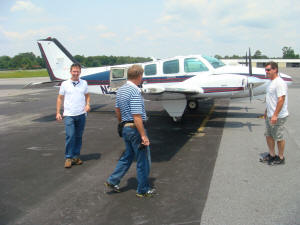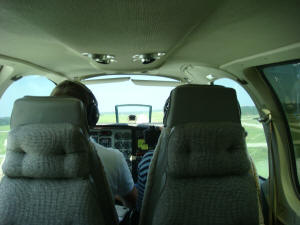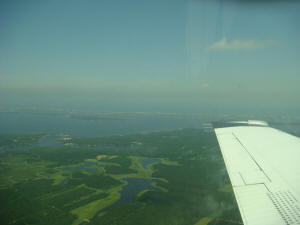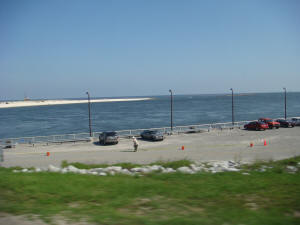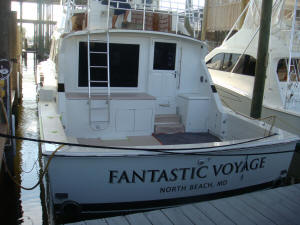That
first afternoon on the boat, it was apparent the boat
was no where near ready for departure. The new
tower for the Flying Bridge was far from complete, work
had barely begun on installing the new electronics.
In the cabin saloon one had to step over boxes and
tools.
The plan was for the two of us in the delivery crew to
remain onboard and push things to a state where we could
depart ASAP. |
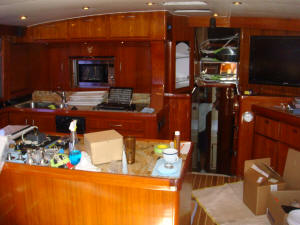
Main Saloon During Commissioning |
| Two weeks later things had progressed, but
completion was a long way off. The owner returned
for an update and several of the vendors started talking
about needing another month for completion. The
owner was being bled to the tune of over $10K per week.
Another month of such charges wasn't going to work for
him. He consulted with us on what was vital for
departure and then put the vendors on notice that those
tasks must be completed within one week. Any other
tasks that could be completed in the time frame would be
accepted and payed for; however, their billable hours
would cease in one week and regardless of the boat's
condition it was leaving. We were willing to
navigate this boat with hand held GPSs, which we
actually did. |
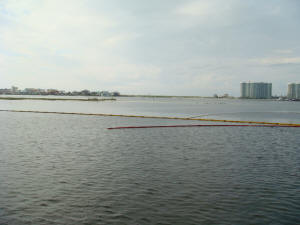
Oil Booms in the GICW |
When
the owner was ready to return to Maine we took him to
Lulu's the tourist trap on the Gulf ICW owned by Jimmy
Buffet's sister. That is right next to the
airport, so at least he could drive the boat a short
distance. On the way we had to navigate the very
shallow channel allowed by the oil booms strung across
the Bayou. |
| After dropping off the owner we headed back to the
marina. Halfway there we were stopped by an
Alabama Marine Police boat and told we could not return
to Orange Beach as the waterway was closed to all but
BP-contracted and governement vessels. It took a
lot of pleading and grovelling (only way to deal with
government officials), but we were allowed to return
to the marina after a suitable lecture. Apparently
a notice was posted at the marina office that the
waterway was closed. The office is a long way from
the boat berth and nothing was posted near the boat. |
|
A
week later, on July 30, good to our word we
finally departed the marina heading for Maine.
The Furuno radar and MFD were working, the
Flying Bridge tower was completed and the canvas
and vinyl enclosure of the bridge was partially
completed. Although boat had two working
GPS, the captain elected to do his navigation on
two hand-held Garmin GPS that he had brought on
board. |
|
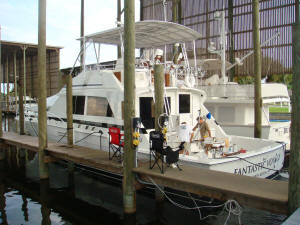
Fantastic Voyage Before Departure |
| Orange Beach to
Panama City |
Since
the boat was barely commissioned we elected for
a short run down the Gulf ICW to Panama City on
the first day. That was not really a
choice as the Perdido Pass was still closed to
all but BP and Government vessels.
We still had to run the guantlet of oil booms
and skimmers making our way from Orange Beach
to the ICW. |
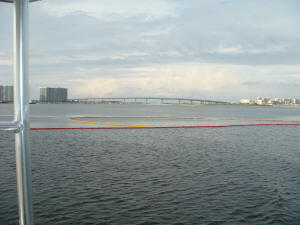
Perdido Pass, AL |
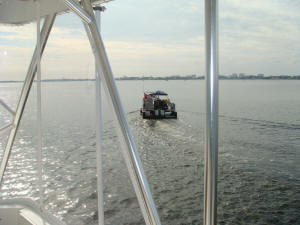
Practicing for Oil
Skimming |
Virtually
every boat in Orange Beach was operating under
contract to BP. |
|
Once
in the GICW we moved quickly through Pensacola,
FL. We stopped to top off the fuel tanks
at Destin, FL |
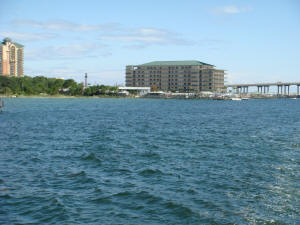
Destin, FL |
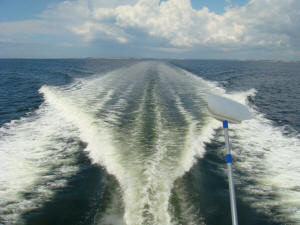
Wide Open Throttle (WOT) |
As sailors we did enjoy the incredible amount of
power on this yacht. |
|
Then
we entered the canal from Destin to Panama City. |
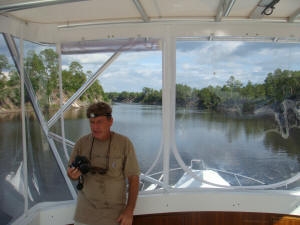
In the Canal to Panama City |
|
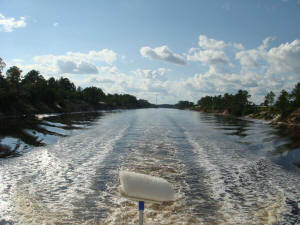
Throttled Back, Sorta |
Although
we really enjoyed pushing this yacht at 15-18 kts (it is
capable of 30kts), we
did have to slow down and reduce the wake when passing
close by other vessels in a restricted space such as
the canal.
That night we anchored in the bay at Panama City. |
| Panama City to
Apalachicola |
|
We
got underway from Panama City just before dawn
and headed out into the Gulf for the run to
Apalachicola |
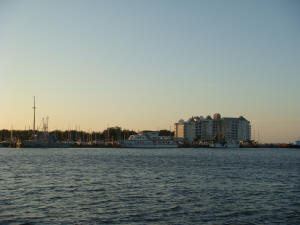
Panama City, FL |
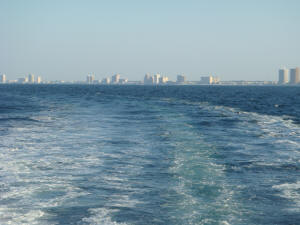
Departing Panama City |
At
first conditions were ideal as we headed SE out
of Panama City. There was a 12-15kt breeze
out of the east which was kicking up a steep
chop, but the big Bertram was handling it easily.
We expected an easy run to Apalachicola.
However when we turned due east into this chop
conditions changed dramatically. We were in
shallower water (35'-50') and the chop built
from 2-3' to 4-5' with occasional 6' chop. Now
the boat was falling off these waves and
crashing into the troughs. |
Also during
this run the autopilot powered down and could
not be powered up. It took nearly four
hours of hand-steering into these seas, and working
the throttles to get over the crests and
minimize the impact of the troughs before we
would turn north for the entrance to Apalachicola
Bay.
With
the seas on the quarter we could go below and
see how the cabin took all this pounding.
It was not a pretty sight.
|
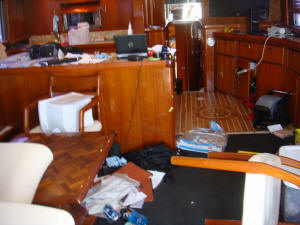
Cabin Mess |
| We spent two nights in
Apalachicola cleaning up this mess and securing
the cabin for a longer
passage in the Gulf to Punta Gorda. |
| Apalachicola to
Punta Gorda, Ft. Myers |
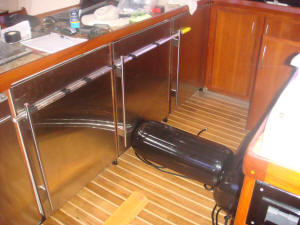
Securing the Refrigerators |
After
straighening up the cabin, fabricating a
bar to latch the three Sub-Zero
refirgerators (which dumped their
contents during the ride to
Apalachicola), and filling the fuel
tanks we departed on our first long run
(240 nm) of this delivery trip to Punta
Gorda.
At this point we did not have confidence
that the fuel guages were correct and we
did not have good metrics on fuel
consumption. We believed with full
tanks and throttled back to 1500 RPM we
would have a range of over 300nm, but we
didn't know how much over. |
We got underway before dawn from
Appalachicola and headed SSE toward the
entrance to Charlotte Harbor and Punta
Gorda. That run was pretty
uneventful, but long. Once more we
hit that steep chop south of
Apalachicola, but this time we had a
better angle on it. By the time we
were off Tampa/St. Pete that chop was
down to 3' or less and the ride smoothed
out. We arrived off Charlotte
Harbor after dark. Before sunset I
had turned on the navigation, instrument
and compass lights. When it became
dark we could see that the compass and
instrument lights were not working.
Without investigating we just assumed
another shortfall of the boat
preparations in Orange Beach. We
planned to investigate the problem the
next day, for now we just wanted to find
a place to anchor the boat and get some
sleep.
We ran up the harbor and turned into the
ICW. About 1 nm into the ICW we
found a wide spot in the ICW and decided
to anchor just out of the channel.
I went on the foredeck to lower the
anchor, but the windlass would not pay
out the chain. I went below and
opened the hatch to the chain locker and
found the that chain was hopelessly
entangled. The rough passage to
Apalachicola had shifted the chain in
the locker.
Fortunately we had purchased a backup
anchor and rode before departing Orange
Beach. That backup was a 22 LB
Danforth with 15' of 3/8" chain - not
something on which we would comfortably ride on
this large yacht, but at least it
would hold the boat in one place while
we sorted out the chain locker.
Untangling the chain required moving all
of it (300') into the forward cabin.
This took several hours. Then we
pulled up the backup anchor and
re-anchored using the primary 55 LB
Fortress and the chain. By this
time it was after 1:00AM and we
were both exhausted.
Before going to sleep I went on the
bridge to turn on the anchor light -
nothing came on. Then I noticed
the navigation light switch was still
on. I checked the navigation
lights and they were off as well. We had run up
Charlotte Harbor and a portion of the
ICW with no lights showing!
It is always better to be lucky than
good.
I left the cabin lights on (125VAC) as
the best I could do for an anchor light.
Did I mention that one of the two
generators had to be running all the
time as everything on the boat, except
the instrument and navigation lights run
off AC? The only time the
generators are shut down is when on
shore power.
The next morning we discovered a GFCI
circuit breaker that had tripped.
That was the reason the navigation, compass and
instrument lights had not come on.
I guess we can't blame all of the vessel
short comings on the crew back in Orange
Beach.
That morning we moved to Ft. Myers and
stopped at the city marina, once more
filling the fuel tanks. |
| Ft. Myers
to Stuart and Ft. Pierce |
| We depated Ft. Myers about 1
hour before dawn the following
day with the plan to make it all
the way across to the east coast
of Florida by way of the Lake
Okeechobee waterway. We
made good time on the
Caloosahatchie River and Canal,
inspite of the tender of one
bridge being late for work and
numerous areas were we had to
slow down to avoid damage to
property and boats from our
wake. |
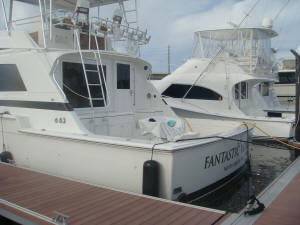
Fantastic Voyage in Stuart, FL |
The
crossing of Lake Okeechobee was
uneventful as the water depths
are near maximum this year.
The we followed the St. Lucie
Canal to Stuart where we took a
berth for the night at a
marina. |
The next day we did not get
underway until the late morning
as we were only going to Ft. Pierce,
about 20 nms. We were
stopping in Ft. Pierce to have
the 50 hour service performed on
the port engine, which had been
re-built over the winter in
Orange Beach.
On the way up the ICW to Ft.
Pierce we struck a submerged
object, possibly a tree trunk.
We anchored off Ft. Pierce and
the captain dived on the prop to
confirm that it was damaged.
Fortunately only one of the
blades was bent, but now we had
two reasons to stop in Ft.
Pierce. |
| We took a berth at the
Harbortown Marina and
immediately made contact with a
diver who would try to fix the
prop in the water. The
owner had already made
arrangments for a mechanic from
the local Detroit Diesel reps to
perform the 50 hour service.
We arrived on Thursday afternoon
and hoped we could get everthing
accomplished on Friday for a
Saturday departure. |
At first things went well.
The diver arrived at 8:00 AM and
within a fiew hours declared
that the prop had been
straightened. The mechanic
arrived around 9:00 AM and
immediately began the 50 hour
service.
Then things started to go down
hill.
|
The mechanic discovered one
of the support for a valve
lifter was loose and needed to
be replaced, then he found oil
in the coolant. Suddenly
we were no longer dealing with a
scheduled service, but the
repair of a re-built engine.
The owner reasonably expected
the cost of the repair to be
born by the yard in Alabama who
performed the re-build.
However it was now late on
Friday afternoon and nothing
would be resolved until the
following Monday. We were
stuck in Ft. Pierce for the
weekend and much of the
following week. |
|
| By Tuesday the Alabama yard had
agreed to send a mechanic to resolve the
engine issues. He arrived on
Wednesday and had the engine ready for a
sea trial on Friday afternoon. We
took the boat out the Ft. Pierce Inlet
and all seemed well except for some
overheating of the port enginge at WOT
(wide open throttle). The mechanic
felt that needed to be checked so we
returned to Harbortown with the plan for
the mechanic to resolve the over heating
problem the next day. The most
likely solution was to replace the oil
coolers. |
| Over the weekend the Alabama yard
and the owner reached an impasse on the
engine work. The yard felt they
done more than required to resolve the
problems and that the oil coolers had
not been touched during the rebuild.
They were willing to continue to work on
this issue only on a time and materials
basis. The owner believed the
yard owed him a resolution to the
problem based on the level of effort and
cost for the re-build. He was
willing to consider payment only when
the problem was resolved and it had been
established that the problem was not
something that should have been detected
and repaired during the rebuild and was
not caused by the rebuild itself. |
The owner and the yard resumed
negotiations on the issue the following
Monday, but could not come to an
agreement. Finally the owner
terminated the work by the Alabama yard
and contracted with the local Detroit
Diesel reps to replace the oil coolers.
By Thursday afternoon the new oil
coolers had been installed and the
coolant flushcd serveral times to remove
the oil and we were ready to depart.
We decided the sea trial for the engine
would be a passage from Ft. Pierce to
Charleston, SC, and planned to depart
early the next morning after nearly two
weeks in Ft. Pierce. |
During this stay in Ft. Pierce the owner
was able to purchase a replacement for the
autopilot control module and sent it to us.
With the installation of that control module we
once more had an operational autopilot - an
essential piece of equipment if we were to push
this yacht to the limit of its fuel range.
| Ft. Pierce
to Charleston, SC and Beaufort, NC |
| Around 4.30 AM we went out the Ft.
Pierce Inlet for the final time and
turned NNE toward Charleston. This
was a trip of over 330 nm. We
still did not have reliable metrics on
the range of this vessel, but based the
amount of fuel we took on at Ft. Myers
we were confident we could make over 350
nm at less than 1500 RPM. |
| A little over halfway to Charleston,
the captain removed the fuel guage
sender from the aft tank and sounded it
with a stick, which showed a fuel depth
of around 3/5 the tank depth. This
was not a flat bottomed tank, but it
showed we had a range significantly
greater than 350 nm. |
| We arrived in Charleston and tied to
the Charleston City Marina Megadock
around 1:00 AM Saturday morning and
spent an hour cleaning the salt off the
boat before crashing for the night.
|
| The next morning we re-fueled and
departed around noon on the 225 nm trip
to Beaufort, NC. |
| Most of this trip was uneventful
except the final 50 or so miles.
Between Cape Fear and Cape Lookout we
encountered a US Navy exercise with what
appeared to be a small carrier task
force. Staying well clear of these
large maneuvering vessels took a lot of
attention and course changes.
Finally we arrived of the Beaufort Inlet
with about 20 kts of wind on our tail.
We had already discovered this boat was
a beast to steer with a following sea.
It was all the captain could do to keep
the boat in the channel as the seas
threw the stern hard to one side or the
other. We also nearly hit a barely
lit channel marker that appeared to be
well within the channel defined by the
range lights in Beaufort. |
|
We arrived in Beaufort around 4:30 AM, tied to an
open space on the Beaufort Docks, did our usual clean up
then crashed for a few hours. We used one of the
Beaurfort Docks courtesy cars to do a little
re-provisioning and then planned to depart the next
morning, possibly for Cape May, NJ.
| When the captain payed the marina bill that
afternoon he discovered that we were charged for
two nights at the marina even though we were
really spending only one night at the dock.
This marina implements its check-in and
check-out times very rigorously. They
considered the time at the dock from 4:30 AM to
11:30 AM a complete day and we were charged
accordingly. This not only made us resolve
to never use the Beaufort Docks again, but also
to not spend another night in a marina on this
delivery until we arrived in Belfast, ME. |
| Beaufort, NC to
Belfast, ME via Ocean City, MD and Sandwich, MA |
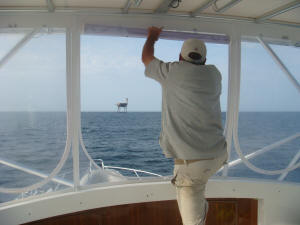
Approaching the Damnond Shoals Light |
Around
10:30 on Monday, July 26 we departed Beaufort
and headed east around Cape Lookout and Cape
Hatteras. On this day conditions were so
light that we were able to closely approach the
abandoned Diamond Shoals lighthouse off Cape
Hatteras. |
|
It
appears this huge facility is now being allowed
to deteriorate and eventually fall into the sea. |
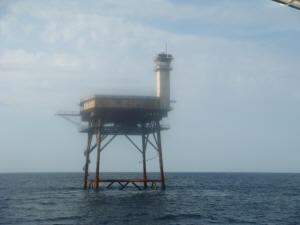
The Abandoned Diamond Shoals Lighthouse |
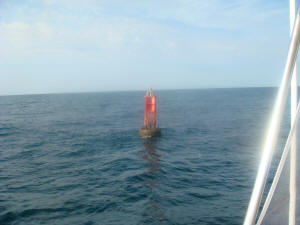
The Lighthouse Replacement |
It
has been replaced by single lighted sea
buoy. |
| By the time we had rounded Cape
Hatteras, Cape May was no longer our
destination. On the run up the
coast from Ft. Pierce we briefly had the
lift of the Gulf Stream, but even out of
the stream we were able to maintain over
14 kts of speed. On this run we
were not even making a consistent 13
kts. So we put into Ocean City, MD
to re-fuel and then immediately headed
north toward Cape Cod. |
|
We
passed east of Block Island at dawn the
next day and headed up Buzzards Bay for
the Cape Cod Canal. |
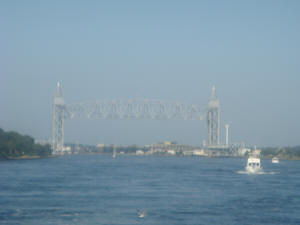
Entering the Cape Cod Canal |
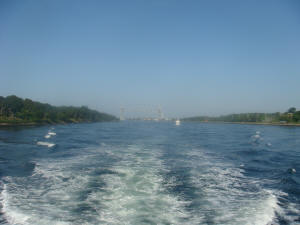
Transiting the Cape Cod Canal |
We
had the current with us in the canal and
quickly completed the transit, then
stopped at the marina in Sandwich, MA to
re-fuel for the last time. |
|
When
we exited the canal a little after noon
we were only 180 nm from Belfast.
This would be the last stop on the
delivery. |
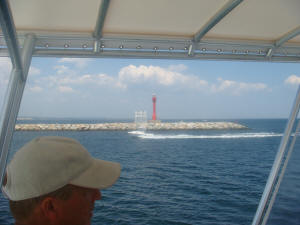
Exiting the Cape Cod Canal |
| We entered Penobscott Bay a
little after dark and tied to
the marina dock in Belfast
around mid-night. This
delivery was finally complete
after nearly 2 months. We
enjoyed the owner's hospitality
in Belfast for one week, then he
flew me back to New Bern. |
|
|
|
|
